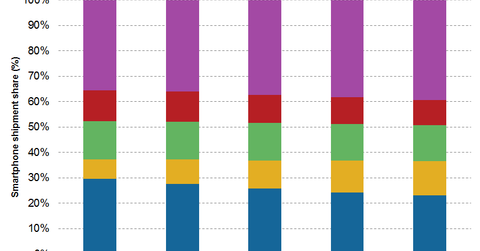How Modi’s ‘Digital India’ Campaign Could Spur Growth
Digital India aims to make government services available to all Indian citizens electronically by providing countrywide Internet connectivity and infrastructure.
Sept. 1 2016, Updated 8:04 a.m. ET

“The transformation to a digital economy… has given the average Indian stature, ownership and identity. It has transformed the marketplace.” – Ratan Tata, Chairman of Tata Sons, 2016
Perhaps the most radical of Modi’s reforms is Digital India, the government’s aim to transform the country into a digitally empowered knowledge economy and to boost standards of governance of citizens through better engagement with the government. The program seeks to bring India into the 21st century with IT at the heart of many industries including education, finance and health. It will also potentially create hundreds of thousands of jobs in IT, electronics and associated industries. One of the aims of the initiative is to allow citizens to access government services electronically and to receive information online, thus eliminating the use of paper documents and allowing sharing of documents across government departments.
Citizens will benefit from fast and efficient access to online government services and important documents like passports and degree certificates. And governments will be able to monitor projects more easily and identify problematic areas that require further attention. Other key aspects involve broadening access to the internet. The infrastructure required is vast – numerous broadband networks will be required to fulfill the government’s promise of broadband in 250,000 villages and public Wi-Fi hotspots for citizens by 2019.[1. Projections are offered as opinion and are not reflective of potential performance. Projections are not guaranteed and actual events or results may differ materially.] Universal phone connectivity is also promised.
Indeed, states are increasingly using the internet to communicate with the public, central government and each other. Some states, for example, are starting to put information on land banks online. Internet connectivity and e-commerce retail sales have grown rapidly in recent years, and the trend is set to continue, as the graphics below show. Digital India, like Make in India, has been successful in attracting significant FDI flows. One of the analysts we met estimated that about 30% of FDI flows are tied to the rapidly expanding e-commerce sector.
Goldman Sachs has noted that the largest employers in India’s premium college campuses are now start-ups, many of them technology-focused. Many smaller technology companies have grown rapidly thanks to FDI and have strong revenue flows. As these companies scale, many need to add human capital and have thereby helped to create new jobs. In addition, the services and products these new companies provide are varied and can help improve lifestyles for consumers or boost work efficiency for businesses and government institutions. Technology is thus not only providing new business and employment opportunities but improving productivity and government services.
Digital India is one of many reforms that is helping make doing business easier in India. It is long overdue – conducting transactions in India is painfully slow and bureaucratic. Widescale government and corporate corruption have been for too long a blight on the efficient and equitable use of funds.
Modi has worked to tackle these problems head on.
Market Realist – Digital India aims to make government services available to all Indian citizens electronically by providing countrywide Internet connectivity and infrastructure. This coupled with the “Make in India” campaign is helping to spur the growth of India (EPI) (PIN) as an emerging smartphone market. More than 36 new mobile phone assembling units have been set up by various companies in the last two years under the Make in India campaign (Source: Deccan Herald).
India (IFN) (INDA) is slated to become the second-largest smartphone market by 2020 as can be seen in the previous graph. As per estimates by the Indian Cellular Association, India currently has the capacity to produce 250 million phone units annually. This is a big step up from estimated capacity of 100 million units in 2015 and 68 million units in 2014 (Source: Deccan Herald). This increase has reportedly generated employment for 40,000 people.
The Digital India campaign is largely benefiting the smartphone market in the country.
